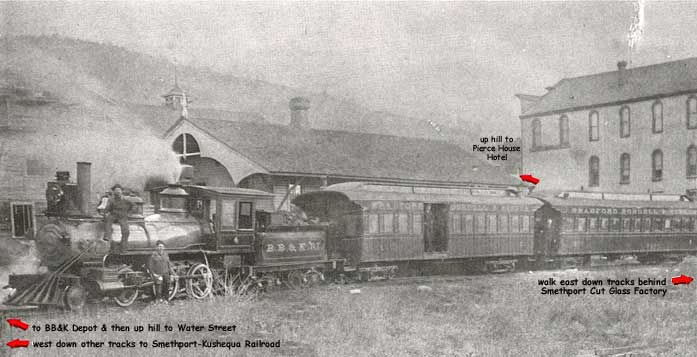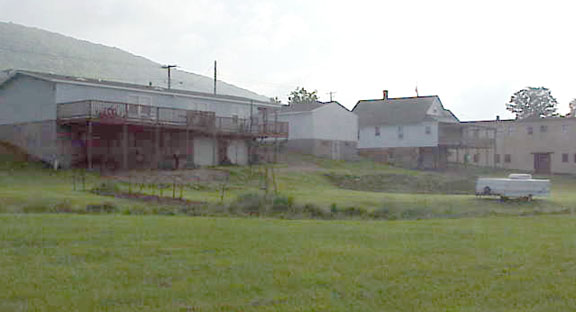A New Century Brings the Competition
of Two New Railroads
Timeless Homes
Two new railroads would serve Smethport beginning
in 1845: the Pittsburg,
Shawmut & Northern Railroad and the Kushequa
Railroad. Neither, however, would have the same impact on Smethport’s
growth and stature as had been sparked by the BB&K.
In 1899 the Shawmut
R.R. and the Kushequa
R.R. both laid track into Smethport at about the same time. In
order to get to the planned destination beyond Smethport, they had
to cross the existing BB&K rails just below where Lake Side Garage
is today. This need to cross the BB&K would lead to a series of
on-going disagreements between the two new railroads.
March of 1899, Elisha Kent Kane incorporated the Smethport Railroad
as a way to connect his
Kushequa system to the Pennsylvania R.R. at East Smethport. The
Smethport Railroad was actually an extension of the Kushequa
R.R., which Kane built from the Kushequa area up Kinzua Creek.
It also went into the Ormsby area in order to tap the timber supplies
that were needed to feed Kane’s huge saw mill in Kushequa. After
crossing the McKean Brothers saw mill at McKeans, just a mile north
of Ormsby, the railroad split into two sections. One section went
down into Cole Creek and headed toward Farmers Valley. The other section
went through Ormsby, and then paralleled the old East-West Highway
(today’s PA State Route 59) down Ormsby hill, around a horseshoe
loop on the hillside behind the Smethport Specialty toy factory, then
alongside the golf course, across Hilton Avenue, and into Smethport.
The McKean County Miner, on October 12, 1899, described the railroad
as “a snake path in the grass,” more than it resembled
a railroad. The line began service on February 26, 1900. The depot
was located just below 701 Water Street (Garvin Dille’s house)
on the west of the entrance to Hamlin Lake Park. The BB&K depot
was only a block east below Church Street. The BB&K tracks blocked
the extension of the Kushequa any further toward East Smethport at
that point.
The Pittsburg, Shawmut
& Northern R.R. arrived in Smethport at about the same time.
The Shawmut,
as it was called, showed little interest in building northward past
the BB&K until it heard that the Kushequa
had received permission by the Borough Council to lay track along
Water Street. The Shawmut
quickly learned of its competitor’s plans and sent an agent
to Smethport. He brought with him a large amount of cash. He visited
each property owner along the proposed Water Street route and bought
the property for the railroad as he went. The
Shawmut then made an agreement with BB&K railroad officials,
who came to Smethport on a special train, to cross the narrow gauge
railroad. A track gang installed the crossing and the
Kushequa Railroad was blocked from accessing East Smethport for
several more years. The
Kushequa filed court action, but it was not resolved for three
decades. Several more years passed before the Kushequa
could get across the BB&K.
Another confrontation between the two railroads occurred a year after
the Keating and Smethport Railroad made a deal with the owner of the
BB&K to have control of the railroad from Ormsby into Smethport.
The K&S operated between the Pennsylvania RR in East Smethport
and the Shawmut in Smethport. The railroad, part of the Kushequa
system, served the Keating Extract Co. in East Smethport to the BB&K
crossing, a total trackage of about a mile. The deal discarded the
BB&K’s Smethport branch from Ormsby into Smethport and to
East Smethport where the BB&K connected with the Pennsylvania
R.R. All freight and passengers coming to Smethport over the BB&K
were forced to change trains at McKeans and take Kushequa trains into
town. This was in January 1905.
The Kushequa
started to change the BB&K’s 3 foot narrow gauge into standard
gauge so that it could finally cross the Shawmut. The Shawmut
disagreed with the legality of the move and took the matter to court.
It wasn’t until 1913 that the court decreed that E. Kent Kane’s
railroad could cross the Shawmut.
While Kane awaited the court decision, he found a way for his railroad
to enter East Smethport. His plan was unique in design. He piggy-backed
his standard gauge cars on to a narrow gauge flatcar pulled by a BB&K
engine. The Kushequa
cars were pulled over the crossing one at a time, and then unloaded
on the other side. This was in the vicinity of the rear of Costa’s
new supermarket near the trailer court. They were then assembled into
a unified train and taken over the now standardized rails of the BB&K
to East Smethport. After the court gave permission to cross the Shawmut
in 1913, most all of the original BB&K line that had been standardized
was scrapped and the Kushequa
relocated along the north edge of the mill pond, then up the valley
and into East Smethport.
Passenger service on the Kushequa
into Smethport ended in 1917. All train service stopped in 1927. The
Shawmut’s
life was 20 years longer. Oddly, the Smethport Board of Trade sponsored
an excursion over the Shawmut
to Mount Jewett in the early days of its existence. The reason for
the trip was to advance industrial development in Smethport, Marvindale,
Hazel Hurst, and Mount Jewett. The glass or wood chemical industries
were well established in those towns. Yet, by the time the
Shawmut Railroad ran its last train through Smethport on April
1, 1947; most of the industries were gone.
All that exists today of these old railroads are the grades that traveled
along the creek or up the steep hillside. Once they were used to transport
passengers and freight from a busy town. Now they serve snowmobiles,
hikers, and fishermen.
These industries weren't the only reason Smethport shared in this
growth. Its position as county seat capitalized on the need for legal
transactions and the subsequent growth of county government.
The Smethport community grew as a result. Hamlin's bank, and later
the Grange Bank, prospered. Merchants thrived.The
community infrastructure modernized, bringing water, gas lights, and
eventually electricity to Smethport. Roads improved, railroad traffic
increased, schools grew, churches increased.
While today finds a less than perfect economic climate, with many
local graduates fleeing the area, there has also been a return to
Smethport by many, bringing answers other than the heavy industry
of the past 150 years. But without that history of industry, Smethport
would still be a quaint town nestled in the valley, between two streams.
|

